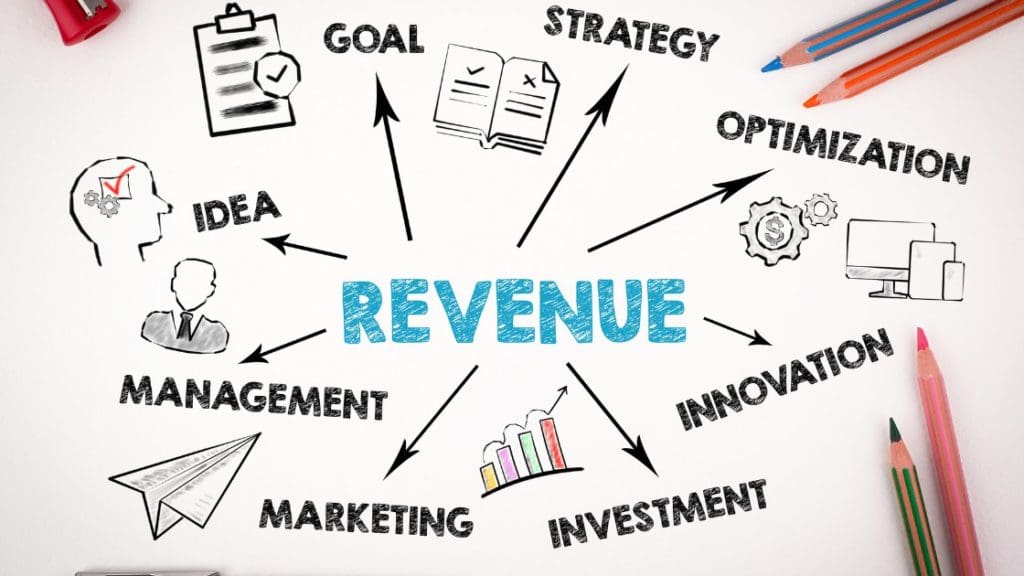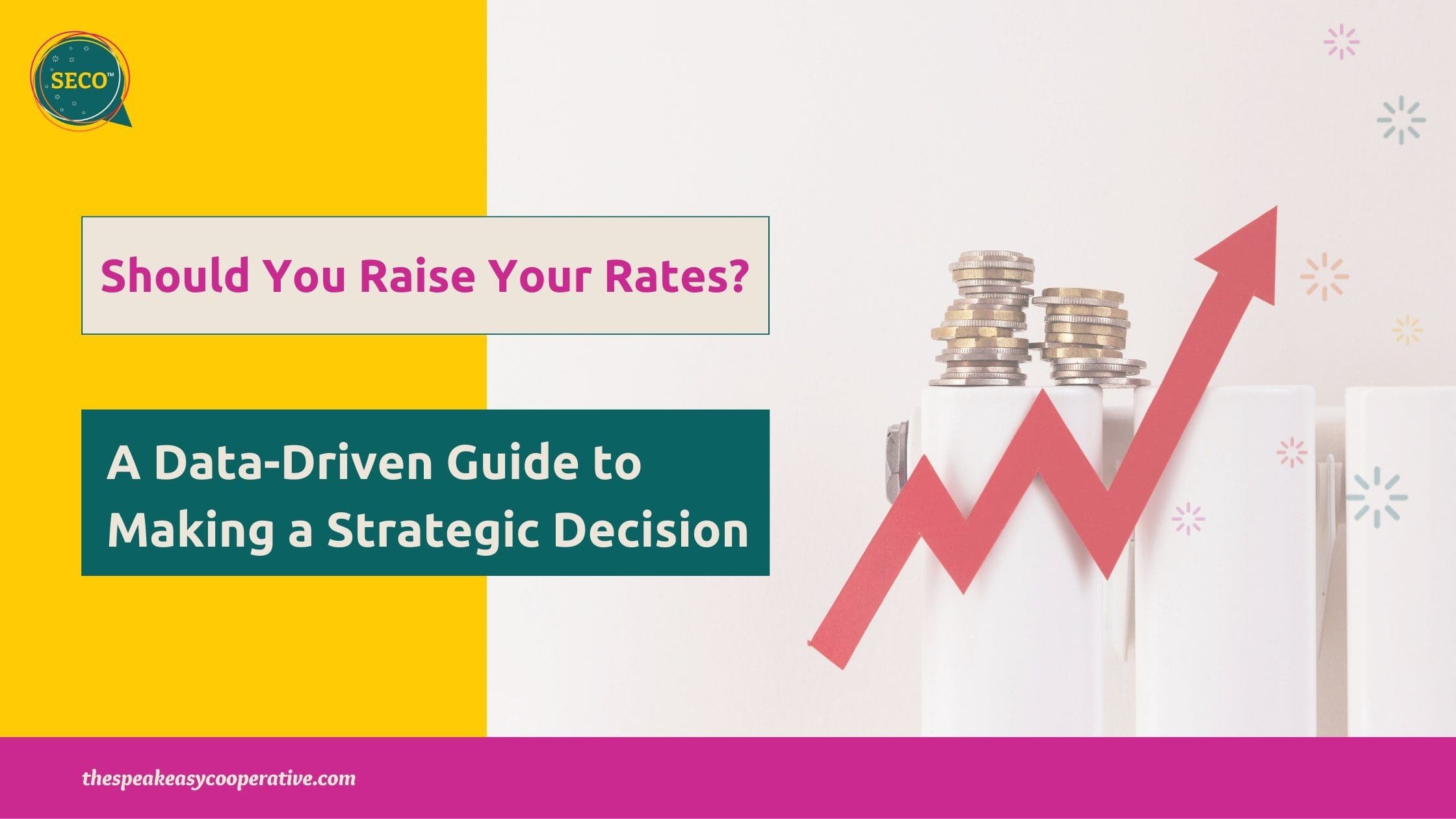We are diving in to the ever-present question in all service based businesses, especially in the Summer as voice teachers and those who work with musicians:
Should I raise my rates? DUN DUN DUUUUUUUUN
Should I raise my rates?
These follow-up questions often accompany the question of whether to raise rates:
- I just raised my rates at the beginning of the year, or in the Spring, can I really raise the rates again, already?
- Should I raise the rates for current clients or just for new clients?
- Can I just, like… raise them? Or do I have to increase what I do/offer in order to justify it?
- Am I gonna break my business and lose all my clients?
To answer these questions, the business owner (that’s you, fabulous!) must be strategic and informed. I’d like to teach you (one way) how!
I’ve made up a business (The Amazing Bizz) for us to use as an example/case study. This is outta my gray matter, so it doesn’t really matter. I made up all the numbers, the needs, the owner’s desires, etc. It’s just an example so that we have something tangible to work with. Your business will look different – because it is!
I’ll break down the process and use The Amazing Bizz to example the process and math for you. Let’s get to it!
Workflow for “The Amazing Bizz” Case Study
Before we actually DO anything, or make any decisions, let’s determine work flow.
Our order of operations will be:
First: State the question(s), figure out what data to gather
Second: Gather the data
Third: Observe the data
Fourth: Analyze the data
Fifth: Make the decision
State the question, figure out what data to gather:
When I say state the question and figure out what data to gather, I mean do a brief check in of what problem you are actually trying to solve, and make a list of other questions that need to be answered so that you can discover what you don’t know yet. In order to make decisions, we can only work with the information we have at the moment. Being mindful of which info we do have and don’t have helps us see the gaps in our decision making process.

The question “Should I raise my rates?” requires more questions. (What? Me ask more questions? Never! Alas, you know me so well.)
- Is the business/you happy with the number of clients it sees a week/number of slots it fills each week?
- Is 1:1 the only revenue stream?
- How many clients can the business afford to lose now and break even?
- Can the business afford a revenue dip… and if so, for how long?
- Assuming you are happy with the amount of clients the business has, and can afford a revenue dip, how long would it take to fill the slots of the lost clients at the new rate?
- By what amount “should” the business raise rates?
- Why does the business want to raise rates?
- What would stop you (the business owner) from raising rates today?
- Are there any other factors that need to be considered that a rate raise would require?
Here is how The Amazing Bizz answers the above questions:
- The Amazing Bizz is happy with a client load of 20 clients a week.
- The Amazing Bizz is a sole proprietorship, and its only revenue stream is 1:1 sessions.
- They don’t know yet
- They don’t know yet
- They don’t know yet
- They don’t know yet
- They don’t know yet. They say they would like to raise their revenue by 30% in the next year. But that’s just a number they have in their head. They want to raise rates because they want to knock out debt and start a retirement account, and maybe go on vacation for once. They just want to.
- What stops them from simply raising rates is FEEEELLLLIIIINGS that are real and BIG. They don’t know yet if it is a smart money decision (will they go broke???), they are afraid to make clients angry with them, and they just raised their rates six months ago, which was the first time they ever did it.
- They are willing to consider a rebrand or brand refresh, but don’t really want to. They do not want to add a bunch of stuff to their current offer, they just want to raise the rate. They are willing to learn how to sell more effectively, even though their current marketing and sales process relies mostly on word of mouth. The personal resources of the business owner means that they would need to be sure to maintain their current revenue to be comfortable, but they do have resources if they were to only maintain at a break-even point. They just don’t know yet.
(I hope you’ve noticed how much they don’t know, yet. You aren’t supposed to know yet. That is the whole point of this process. 😉)
First, let’s determine the data to gather, and do so:
When I say determine the data and gather it, I mean figure out what data and information is needed in order to answer the above questions and therefore, eventually, make a decision.

Oftentimes, we look at subjective information (for example, our feelings about other people’s pocketbooks) before we look at objective information (what dollar amounts make what impact on the business, what our marketing plan looks like, historical cash flow.) This is NORMAL and doesn’t mean you are broken. It just means you need to put the rider of logic on the elephant of emotions for a bit. For the questions around raising rates, we need to know:
- The current total monthly revenue of the business, based on current pricing. You can do an average of this if you like.
- Number of slots being sold/clients paying.
- How much each client is currently paying.
- The new pricing options.
- There are a few ways to do this. I’ll keep it simple.
- Beginners way: Make up three pricing options off your nog. A no-sweat-I’m-comfortable amount, squirmy-I’m-not-so-sure amount, and hold-my-hair-imma-vomit amount.
- Advanced way: Determine the break-even, capital, revenue need, and profit margin the business needs to achieve its goal, first, then base the pricing on this, regardless of aforementioned feelings.
- There are a few ways to do this. I’ll keep it simple.
- The business’s “break-even” revenue – what is the lowest amount of revenue that the business needs to pay all its bills before it goes into the red (is losing money). Depending on the owner’s financial situation and the business entity, this may or may not include the owner’s draws/salary.
- What kind of capital/savings is already in the business, or the owner’s equity available, to put in to make up for any losses that may occur?
- What is the revenue goal? (Yes, I am assuming there is one, why the heck else would you raise your rate? 😘)
- Historical data on how long it takes to acquire one client. You’ll get this by making note of how the business markets, sells, and converts.
Here is the data from The Amazing Bizz:
- Total monthly revenue for all 1:1 clients in The Amazing Bizz is $5000.
- This $5000 comes from 20 clients per month.
- Each client is paying $250/mo.
- New pricing options: $300, $350, $500. (Off my nog!)
- We are gonna do the beginners way in this article because the owner of The Amazing Bizz is brand new to this kind of raising rates thinking. I want you to see that it CAN be done, even when you are new to this kind of thinking and have FEEEELLLLIIIINGS that are real, and BIG. Oh, and ALSO, you gotta pay us to teach you the advanced way because time and math and a total shift in perspective. It’s work.
- The Amazing Bizz needs to make $2000 to break even. This includes all the bills the business pays monthly, but does not include the owner’s draw. The owner is supported by a partner and will not lose access to shelter, food, or medical care, but would still like to get back to $5000 (at least) as soon as possible.
- There is $10,000 in The Amazing Bizz business savings. The owner does not want to pay into the business with their personal money (aka owners equity).
- The Amazing Bizz is going for a 30% revenue increase in the next year or so. (THIS IS A LOT but hey! Dream big!)
- Historically, with its current marketing and sales process, it has taken The Amazing Bizz about 2 months to acquire one client.
Now, we observe – this is usually the math part:
When I say observe, I mean we sit in neutral mind space, without judgment of the data, and use it to calculate and/or create scenarios. It is vital to separate observation from analysis and decision making. When we observe data, we are free to look at it from different angles and perspectives. We can play “what if?” and practice acceptance of what is, without being awash in (not yet helpful) emotion. We will use emotions later! They are important, too! Just not yet.
- If the rate is $300/mo per client:
- 100% retention, revenue is $6000/mo
- 20 clients x $300 = $6000
- 85% retention (-3 clients), revenue is $5100/mo
- 17 clients x $300 = $5100
- 35% retention (-13 clients), revenue is $2100/mo
- 7 clients x $300 = $2100
- 100% retention, revenue is $6000/mo
- If the rate is $350/mo per client:
- 100% retention, revenue is $7000/mo
- 20 clients x $350 = $7000
- 75% retention (-5 clients), revenue is $5250/mo
- 15 clients x $350 = $5250
- 30% retention (-14 clients), revenue is $2100/mo
- 6 clients x $350 = $2100
- 100% retention, revenue is $7000/mo
- If the rate is $500/mo per client:
- 100% retention, revenue is $10,000/mo
- 20 clients x $500 = $10,000
- 50% retention (-10 clients), revenue is $5000/mo
- 10 clients x $500 = $5000
- 20% retention (-16 clients), revenue is $2000/mo
- 4 clients x $500 = $2000
- 100% retention, revenue is $10,000/mo
- If it takes about 2 months to acquire one client, and The Amazing Bizz makes no changes to its marketing and sales process, here is what can be reasonably expected:
- It will take about 6 months to gather 3 new clients
- It will take about 10 months to gather 5 new clients
- It will take about 20 months to gather 10 new clients
- The Amazing Bizz has $10,000 in savings; the break-even point is $2000, without an owners draw. Here is the break even runway (how many months it could maintain break even before running out of savings):
- 0% revenue retention (-$5000 revenue) = 5 month runway
- 20% revenue retention (-$4000 revenue) = 10 month runway
- 40% revenue retention (-$3000 revenue) = no savings needed to break even
- 60% revenue retention (-$2000 revenue) = no savings needed to break even
- 80% revenue retention (-$1000 revenue) = no savings needed to break even
- The Amazing Bizz has $10,000 in savings; the break even point is $2000 + owners draw is $5000. Here is the break even + owners draw runway (how many months it could maintain the current cash flow feel of $5000/mo before running out of savings):
- 0% revenue retention (-$5000 revenue) = 2 month runway
- 20% revenue retention (-$4000 revenue) = 2.5 month runway
- 40% revenue retention (-$3000 revenue) = 3 month runway
- 60% revenue retention (-$2000 revenue) = 5 month runway
- 80% revenue retention (-$1000 revenue) = 10 month runway
Now, we analyze:
When I say analyze, I mean take a look at how all the data that is gathered interacts with the assumptions we made before we had data and desired outcomes. I mean we look at both short term and long term consequences. We take into account how this data will be perceived over time, and how it impacts the business over time. We poke at the data, add in some emotional realities, and come to terms with what would have to change if we were to choose different paths. We look at our options – we always have options!

- Take into account the business’s goals and how long the business has until the goals must be realized, or the business folds.
- Take into account the relational capital that you’d like to spend. It’s worth it to spend it – decide on when, on who, and for what purpose.
- Take into account your personal risk tolerance as the business owner.
- Be mindful about the difference between low risk tolerance and fear – know where either is coming from.
- “People might not like me” is not a good reason to postpone a pricing shift that will allow you to do your work better. This is fear. It’s real, but you can’t control it because it centers on other people’s thoughts and feelings. Just raise them.
- “I will not be able to pay my rent” is a good reason to postpone a significant pricing shift until there is a solid plan. This is risk tolerance. It’s real, and you have control over it. Raise them a little to reduce people leaving, but use the extra income to build up more savings.
- “I am going to lose all my clients” This is the risk that people like to bring up before they actually crunched numbers, so we can cross this one off the list because it can be quantified. It is the fear that causes us to amplify the risk.
- Deep money trauma is 100% a reason to postpone pricing shifts. Get thee to a trauma informed money coach or therapist. This post assumes we are not having money trauma. Remember that fear, self-sabotage, and feeling like you are gonna vomit is a way your body is protecting you and keeping you safe. Work with someone to help get you regulated around money stuff. We can help, too.
- Remember – raising rates is a matter of what your desired outcomes are and what you’re trying to accomplish in the business over the long haul.
- Resist getting sucked into making short term decisions to achieve long term goals. Think about the money you need to earn in three, six, or nine months – not the money you need to earn tomorrow.
- Think about how your feelings will shift over 10 minutes, 10 months, and 10 years.
- Think about how the business is impacted over 10 minutes, 10 months, and 10 years.
Here is a (brief) analysis of The Amazing Bizz’s data:
The Amazing Bizz is in a great position to raise rates! Let’s look at some options.
Scenario One
If The Amazing Bizz raised the rate to $300, they could sustain losing 15% of their clientele (3 people) and maintain their current revenue of $5000. If they retained all the clients, they would have increased their revenue by about 20% immediately.
Even if they retained only 7 clients, they would still be making $2100, and not have to dip into savings to break even. If they chose to supplement their revenue from savings, they would have about have three months of runway before they ran out of savings.
The Amazing Bizz would then need to bring in an additional ten clients (17 clients total) to bring the business to $5100/mo in revenue. This may not be doable with the current marketing systems, as this would take about 20 months.
Even with that reality, marketing and sales would need to be tweaked, but not too much, because honestly, the only people leaving for a $50/mo increase are people who were looking for a reason anyway, or people who had a significant rate raise thrust upon them in other areas of life that you can’t control anyway.
In ten minutes, this will feel fine and the business overall will most likely stay pretty consistent.
In ten months, this will feel fine, and the business may or may not reach their 30% revenue goal, since if all the slots are filled at the $300/mo rate, the only way to get to a 30% revenue goal is to raise rates again.
In ten years, this will have been one of many small increases. It is unclear if long term goals of savings, retirement, vacations will be reached.
The risk: Relatively low for a ~17% rate raise. Maybe people who were effected by a recent hike would bail. A decent messaging execution would be in order.
The reward: Almost immediate revenue increase!
Scenario Two
If The Amazing Bizz raised the rate to $350, they could sustain losing 25% of their clientele (5 people) and maintain their current revenue of $5000. If they retained all the clients, they would have increased their revenue by about 30% immediately.
Even if they retained only 6 clients, they would still be making $2100, and not have to dip into savings to break even. If they chose to supplement their revenue from savings, they would have about have three months of runway before they ran out of savings.
The Amazing Bizz would then need to bring in an additional nine clients (15 clients total) to bring the business to $5250/mo in revenue. This may not be doable with the current marketing systems, as this would take about 18 months.
Even with that reality, marketing and sales would need to be tweaked and a very clear and high touch transition plan would need to happen since this is a $100/mo rate hike – it could put The Amazing Bizz into a new client bracket, or not. People who were looking for a reason to leave will leave. People who simply cannot afford it will leave. Many will grumble, but ultimately stay.
This rate hike is 30%, which in the client’s eye will feel differently than a 17% hike. The business will probably sustain more client losses, but this will open up the slots for new clients that will be onboarded to the new rate from the get go, allowing for faster revenue growth over time.
In ten minutes, this will feel very uncomfortable. The business overall will most likely stay pretty consistent, albeit lose several clients and need to dip into savings and/or adjust marketing and sales.
In ten months, this will feel pretty good! Even if they lost 14 clients at first, in ten months the business will have recovered five additional clients, bringing monthly revenue to $3850. The business owner will need to decide to simply take a lower owners draw for a while, or continue to stretch the savings account as revenue increases.
In ten years, this will have set the business up for increased capital, quickly, and allowed for some of the goals around retirement, savings, and vacations. While it is unclear if those goals will be reached, but precedent would have been set for making dramatic change.
The risk: This rate hike is 30%, which in the client’s eye will feel differently than a 17% hike. It will feel like “a lot” to those who have been used to getting the same thing for a lower cost. The business will probably sustain more client losses, but that will open up the slots for new clients that will be onboarded to the new rate from the get go. Marketing and sales would need to be addressed more presently.
The reward: The client losses will allow for more revenue, more efficiently, as new clients are gained. Each new client will have expectations in alignment with the price point.
Scenario Three
If The Amazing Bizz raised the rate to $500, they could sustain losing 50% of their clientele (10 people) and still maintain the current revenue of $5000. If no one left, they would have increased their revenue by 100% immediately.
Even if they retained only 4 clients, they would still be making $2000, and not have to dip into savings to break even. If they chose to supplement their revenue from savings, they would have about have three months of runway before they ran out of savings.
The Amazing Bizz would then need to bring in an additional six clients (10 total) to bring the business to $5000/mo in revenue. This will most likely not be doable with the current marketing systems, as this would take about 12 months.
Even with that reality, marketing and sales would absolutely need to be addressed. A very clear and high touch transition plan would need to happen since this is a $250/mo rate hike – it will put the business into a new client bracket, no doubt. Additionally, the business is ultimately changing the offer perception in the market. Future clientele may take a little longer to go through a sales process and onboard as The Amazing Bizz figures out how to market and sell at this price point. That being said, the clients who “really get it” about The Amazing Bizz’s amazingness will stay. Most will leave. Again, The Amazing Bizz would essentially need to leverage perception different brand, need to show the value differently to current clientele, and boldly change their sales strategy.
In ten minutes, this will feel either extremely freeing OR ridiculously scary. The business will likely change and turnover many clients, and need to revamp their marketing and sales process. It has the potential be a ton of work and emotional labor.
In ten months, this will feel GREAT! Even if they lost 16 clients at first, in ten months the business will have recovered five additional clients, bringing monthly revenue to $4500. The business owner will need to decide to simply take a lower owners draw for a while, or continue to stretch the savings account as revenue increases.
In ten years, this will have completely changed the business. Not only is there increased capital, all goals around retirement, savings, and vacations are well underway. And, bonus, the lessons learned from doing this will be invaluable for future business risks.
The risk: It’s a hard sell to current clients at a 100% rate increase, but not impossible. The business will sustain client losses. There may be emotional burnout, stress, worry. May take an amount of time that feels way too long to “get back on track”.
The reward: The business is completely changed from a financial perspective because of all the client losses that will open up the slots for new clients that will be onboarded to the new rate from the get go, essentially allowing for increased revenue pretty quickly. Which will lead to the business owner learning a lot about themselves and what they are capable of. It will put the business on a significant growth trajectory.
Let’s apply it and make a decision:
When I say make a decision, I mean what action will be taken based on analysis and some good ol’ fashioned hat-over-the-fence hutzpah. This is the thing you will try first. Decisions can only be made based on the information and data you have at the time. By now, you will have as much data and information as you can, so you are ready to make a decision. Action brings clarity. This is the fun part, I promise!
Most importantly, this is where YOU as the BUSINESS OWNER come in. There is no wrong decision. Because you won’t know if it “worked” until after you see how it plays out. Decisions are part logic and part emotion. My decision might be different than yours!
The Decision I Would Make
If I were the owner of The Amazing Bizz, I would immediately implement the $350 rate raise, prepare for 10 people to leave (because I like to prepare for the worst, because I have lower risk tolerance), and expect to pull in $3500 in revenue per month.
I’d revisit my need for an owners draw, talk with my hubby about what we could swing, and give the business as much of a runway as possible so that I could make the most of the $10,000 in savings.
I’d tweak my marketing and sales and give myself three months to get three clients at the new $500 price point, so I only wind up using a total of $4500 of the savings account to make me flush over the three months I was gathering the new clients..
I’d prepare to use up to $2000 to invest in a marketing coach and sales coach to help me develop a new process and set up any software systems that I needed to bring the sales in I desired.
That would leave the business $3500 in savings, which I would fund again as soon as the business reached any amount over $5000/mo.
Yep-you read that right- I’d raise the rate on current clients to $350, to reduce attrition, then only sell the $500 price point to the new clients, and call it a day. As clients on the $350 price point left due to natural attrition, I would replace them with $500 price point clients. At the point that 75% of clients were at the $500 rate, I would transition the old clients to the $500 price point, or release them to be served by someone else.
Well, That Was A Romp…
Okaayyyyyyy… we did it!
It’s always a little awkward to end articles like this because there isn’t much more to say.
I’m really excited about this article, and I hope that this article has given you the permission and information you need to raise your rates.
After all, someday it will be your biz we are talking about – and you’ll be able to make a decision with surety and peace. I know you will.
My wish is that this article has shown you that there is no moral or ethical standard or attachment to when we raise prices, even though the world would like us to think there is. That we can make this kind of decision with a strategy in mind and that all changes involve risk and reward.
Most of all, I hope this empowers you to retrain your brain to the order of operations, and remember that data gathering and observation is a neutral process that needs to happen before analysis.
I guess I’ll leave it at that for now.
What would YOU do as the business owner of The Amazing Bizz, with the information you’ve now gathered, observed, and analyzed? Let me know!
All My BeastyBoss,

P.S. Speaking of raising rates, if you’ve been considering joining SECO, jump on it to lock in the current rate of $69/mo. (First month includes a one time sign up fee of $100) The new rate of $99/mo (no sign up fee) will go into effect in a few months. If you are already a member, your $69 rate is locked in for the duration of your membership. And as always, if you cancel, and want to rejoin, that’s no problem – you are always welcome back – you’ll just pay the rate that’s in effect at the time of the rejoin.
Read these next:
Do not “Charge what you’re worth”
What Is a Business Plan and When Would I Need One?
What’s In Your Hour: Your Definitive Guide to Pricing Your Services
Why It’s Imperative For Voice Teachers To Increase Rates Now
The Art of the Inquiry:
The Secret to Revenue, Relationships, and Retention
Discover each step of the inquiry process and get tangible actions items to implement in your own business right away. GET YOUR COPY HERE.







0 Comments